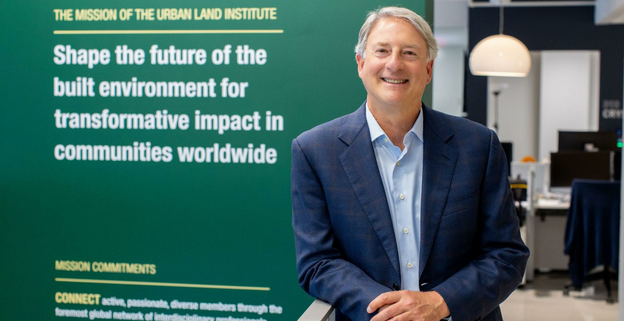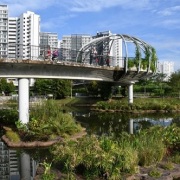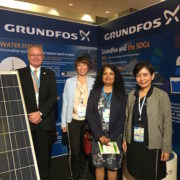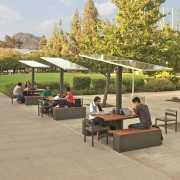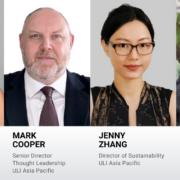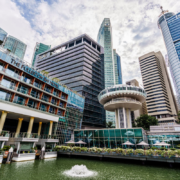ESG Takes Centre Stage in Revolutionising Asia Pacific’s Real Estate Industry
Building Review Journal spoke with Ron Pressman, the Global CEO of the Urban Land Institute (ULI), a global organisation focused on promoting responsible land use and sustainable communities.

As the world becomes more aware of the urgent need to address climate change, many industries are taking steps to become more sustainable. Real estate, which accounts for a significant portion of global greenhouse gas emissions, is no exception. But what does it mean for the real estate industry to be sustainable? And how can developers, investors, and policymakers work together to pave a more sustainable way forward? In this interview, Pressman shares his insights on the challenges and opportunities facing the real estate industry, the role of technology and policy in promoting sustainability, and the importance of engaging with local communities in sustainable development.
1. What do you see as the biggest challenges and opportunities for the real estate industry in terms of sustainability?
Real estate represents around 40 percent of the annual carbon emissions. While very fragmented across trillions of square feet of global real estate, it represents the largest segment of addressable carbon emission reduction opportunities. So, it is important to galvanise focus on this. Two big reduction opportunities are running buildings more efficiently and building new projects more sustainably. Roughly two-thirds of the annual global emission footprint arise from operating existing buildings. There are many ways to reduce this via updated heating, cooling, and building management technology. New build embodied carbon from construction, materials, and transportation represents the other “third”. There are many new options to build to a more efficient standard embracing sustainable construction and materials leadership practices.
One of the biggest sustainability challenges for the real estate industry is navigating the regulatory and reporting environment, and then ensuring that the organisational metrics will result in accurate measurement against these regulations and standards. Transparency on sustainability is no longer optional – stakeholders across the industry expect the real estate sector to clearly report on their sustainability performance and progress against goals. The industry is dealing with an alphabet soup of climate regulations and policies that overlap, compete and differ by country and region. There is a lack of consistency globally, and waiting for one is not an option. Therefore, the sector must work together to successfully navigate the road ahead. Collaboration and a balance between ‘quality’ and ‘quantity’ should be the focus.
On the other hand, as the industry pivots to mitigating climate change risks, there are opportunities to bring competitive, cutting-edge buildings to the market. New projects now have ESG regulations and standards embedded by default, and legacy buildings are also being retrofitted to be up to date with the same standards amid the global push for greener buildings. Real estate owners and developers who are proactively incorporating sustainability opportunities into their assets are benefitting from the competitive advantage of green premiums like high-performance buildings, higher quality tenants, lower tenant turnover, and increased asset value.
2. How can real estate developers and investors incorporate sustainability into their decision-making processes?
Conducting a sustainability assessment is one of the ways sustainability can be incorporated in decision-making processes. This includes incorporating sustainability considerations into decisions regarding due diligence, property condition assessments, financing, building operations, and disposition.
Before investing in a property or beginning a development project, it’s essential to conduct a sustainability assessment. This involves evaluating the environmental impact (and associated investment needs) of the project, including factors such as energy consumption, water usage, waste generation, and carbon emissions.
Specifically, the investors should actively understand climate change adaptation needs for key markets. This requires investors to shift from an asset-centric view to a market-level appraisal of risk and resilience drivers. They should consider ways to leverage technical expertise to build the capacity of communities to absorb climate shocks and stressors. Building resilience against the impacts of climate change will require a cooperative ecosystem made up of public, private, non-profit, and academic institutions. To these ends, investors can support the creation of robust community resilience and recovery plans and should direct their investment to infrastructure and real estate asset classes that are climate responsive, adaptable to changing environmental conditions, and enhance the overall social and ecological resilience of communities.
A fundamental problem recognised in Europe is the failure of valuation processes to take account of climate transition risks. High values in an area of high demand can mask the potential for environmental underperformance to lead to an asset stranding while low values in secondary areas undermine the business case for retrofit. Values that reflected transition risk would help to embed sustainability in decision-making.
3. What role can technology play in creating more sustainable buildings and communities?
Aligning sustainability with innovation strategies is one of the key priorities for real estate companies in Asia Pacific, with ESG considered a significant factor in the decision-making for new technologies. PropTech solutions, and more recently ClimateTech solutions, offer tremendous opportunities to advance building decarbonisation and resilience.
By incorporating technology into their operations, building owners and developers can optimise energy usage, reduce greenhouse gas emissions, improve occupant health, bolster resilience against physical climate hazards, and improve the overall sustainability of their buildings and communities.
For example, building automation systems (BAS) can optimise the use of energy and the emission of carbon by automating various functions, including heating, cooling, and lighting, turning them on only when someone is in the room, or shifting some of the building’s energy load to times when the utility grid is cleaner.
4. How can urban planning and policy support more sustainable real estate development?
Urban planning and policy can play a critical role in supporting more sustainable real estate development:
- Zoning regulations can enforce more sustainable development patterns, such as mixed-use development, transit-oriented development, and walkable neighbourhoods. Zoning regulations can also require the inclusion of green space, sustainable building materials, and energy-efficient features in new development projects.
- Transportation planning can promote sustainable options such as public transit, bike lanes, and pedestrian-friendly streets. This can reduce greenhouse gas emissions and improve air quality by going car-lite or even car-free.
- Community engagement is also a crucial element of sustainable urban planning and policy. Engaging with the public in the development process can ensure that the project meets the needs of the local community, respects their values and culture, and helps to create more liveable and sustainable neighbourhoods. It can also help to build support for sustainable development projects, which is essential for their success.

5. What are some examples of innovative and sustainable real estate projects that you have seen around the world?
One of the winners of the 2022 ULI Asia Pacific Awards for Excellence – Wesley Place (pictured above) – is a commercial office project on a 1.1-hectare site near Melbourne city centre, featuring a high degree of sustainability technology, including a thermally efficient façade, smart metering, rooftop solar, waste monitoring and recycling.
However, the project was designed with the S (social) in ESG in mind as well. The office building is complemented by a 5,000-square-metre, nicely scaled, landscaped plaza on the ground floor. The plaza retains 150-year-old trees and has 24-hour public access connecting to a variety of other buildings and amenities.
In addition, the project site incorporates a collection of five significant heritage buildings dating to 1837, including Wesley Church together with its associated Manse. Following long negotiations with Church authorities, the buildings and surrounding spaces have been extensively refurbished, with close attention to details such as restoring stained glass windows and sourcing appropriate masonry from as far away as Europe. The church has remained a place of worship, while the other buildings have been adapted to various commercial purposes, including a café/restaurant in the Manse building that has been integrated into the office-building lobby, creating a unique experience for occupants.
The exercise was successful not only as an example of urban heritage preservation carried out in a way that retains the density required by the CBD location but also as a template for leveraging the commercial value of the office buildings to carry out refurbishment in a situation where financing would probably not otherwise have been available. The theme of adaptive reuse is further strengthened – currently, a separate, rather anachronistic 70s-era building located nearby is also now undergoing refurbishment as opposed to demolition.
6. How can the real estate industry balance the demand for affordable housing with the need for sustainability?
It’s a common misconception that a building can’t be both affordable and sustainable. Affordable housing runs on thin margins, so meeting sustainability goals can require getting creative with funding, financing, and strategy. Depending on the regulatory environment of the locale – the availability of grants, incentives, technology, etc. – the level of difficulty would vary. Often, affordable housing runs on a master utility meter – so when the building reduces energy costs, it’s the owner who benefits from the savings. Residents benefit from higher performance and healthier living spaces, while owners benefit from lower operating expenses. District heat networks can bring similar benefits.
Another approach could be to view housing as part of a larger set of systems of mobility, access to jobs and services, and urban infrastructure. Energy, water, and food systems need to be considered as enablers for affordability, and in a context that enables liveability and equity for everyone who connects with it. All industry players should consider how affordable housing can be more than an independent goal – and explore how it can also contribute to a greener community in the long run.
7. How can the industry engage with and address the concerns of local communities when it comes to sustainable real estate development?
One of the pillars of sustainability is social – i.e., the well-being of the communities in which an organisation operates, or in this case, where the real estate project is being set up. Collaboration across the real estate value chain is proving essential to achieving global sustainability goals. This collaboration includes real estate working alongside governments, community members, tenants, and supply chains. It is an indication that the social element of ESG is genuinely being addressed. This engagement also ensures that new development’s amenities serve the needs of the local community – sometimes developers’ assumptions do not match actual desires.
One emerging topic is to view building utilisation as a solution to sustainability in the built environment. For instance, developers can explore how the surrounding community can use spaces to avoid duplication of amenities that already exist in an area, thereby optimising resources to create more diversified facilities and adaptable spaces. It goes without saying that directly engaging local communities to exchange feedback and address their concerns, such as through dialogue or briefing sessions, should also be of importance. This could mean, for example, carving out space on site for an open park, providing a community food garden (agrihoods), or adding additional EV charging parking spots.
8. What role do you see public-private partnerships playing in advancing sustainability in the real estate sector?
Public-private partnerships (PPPs) can play a significant role in advancing sustainability in the real estate sector by combining the strengths and resources of both the public and private sectors. Private sector expertise and capital can be leveraged to address sustainability challenges that may be too complex or costly for the public sector to tackle alone. On the other hand, governments can help mitigate risks for developers; this, in turn, raises their willingness to invest in sustainable development. This way, the sharing of risks between both parties can produce win-win outcomes in PPP projects.

One such example in Singapore is Eco@Punggol (pictured above), Singapore’s first eco-town. The award-winning project was initiated by the Housing Development Board (HDB), Singapore’s public housing authority, in partnership with various private sector companies. The eco-town features a range of sustainable living initiatives and amenities that enable eco-friendly high-rise living, such as effective energy, water, and waste management. The development also includes a comprehensive network of pedestrian and cycling paths, as well as an extensive public transportation system to encourage the use of sustainable transportation options.
9. How can the industry measure and report on its progress towards sustainability goals?
Over the last 10 years, the avalanche of new ESG reporting requirements applicable to real estate has presented a significant challenge. Keeping up has not been easy, even for the most ambitious organisations with the greatest resources to allocate to the area. In addition, there are different views on what must be prioritised, disclosed, against which criteria, for what purpose and whether commitments will stand up to scrutiny.
It is important to understand the purpose of the different ESG frameworks and standards and the intended user of the information – there is no one-size-fits-all standard. Accordingly, an organisation will need to choose the right standards and metrics that appropriately reflect the requirements of their ESG strategy and their overall environmental impact and comply with minimum social standards throughout the entire real estate lifecycle in value and supply chains.
To help industry players navigate the vast selection of different regulations and standards, ULI has created self-assessing questions that organisations can use to map the core issues and foci of their ESG strategy to the required and appropriate standards and regulations. One of the greatest advantages of streamlining measurement and reporting is that it frees up time for action that we know is needed.
Wesley Place image courtesy of Cox Architecture
Eco@Punggol image courtesy of HDB


